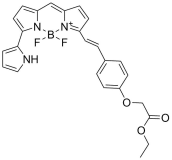BDP 650/665 (also know as BODIPY 650/665) is a boron-dipyrromethene dye with far-red excitation and emission. Compatible with Cy5 channels on many instruments. The dye has good molar extinction coefficient and emission quantum yield.
- Absorption Maximum: ~650 nm
- Emission Maximum: ~665 nm
BDP 650/665
BDP 650/665: Spectral Properties and Applications
BDP 650/665 (Boron-Dipyrromethene 650/665) is a far-red fluorescent dye known for its bright fluorescence, excellent photostability, and distinct spectral properties. It is widely used in advanced fluorescence applications, including microscopy, flow cytometry, and FRET, due to its ability to provide strong signals with minimal background interference.
Spectral Properties of BDP 650/665:
- Absorption Maximum: ~650 nm
- Emission Maximum: ~665 nm
- Stokes Shift: ~15 nm
- High Quantum Yield: Offers strong fluorescence, ideal for high-sensitivity detection.
- Photostability: Resists photobleaching, maintaining signal intensity during extended experiments.
- Sharp Spectra: Narrow absorption and emission peaks reduce spectral overlap, enhancing clarity in multiplex assays.
Applications of BDP 650/665:
- Fluorescence Microscopy: Suitable for high-resolution imaging of cellular structures and processes.
- Flow Cytometry: Provides clear and distinct signals for cell sorting and analysis in complex samples.
- FRET Studies: Used in FRET assays to study molecular interactions with high sensitivity.
- Molecular Probes: Ideal for labeling proteins, nucleic acids, and other biomolecules in various research applications.
BDP 650/665’s bright far-red fluorescence, stability, and well-defined spectral characteristics make it a top choice for researchers seeking reliable and precise detection in advanced fluorescence-based studies.


